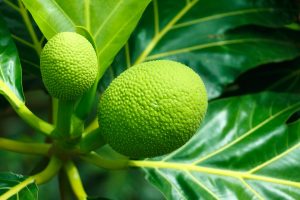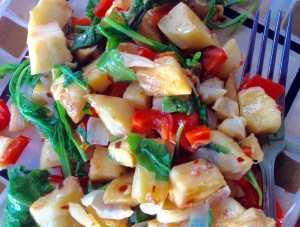Ulu: An Ancient Food Still Sustains Us
Hawaiian mythology tells us that the war god Kū lived happily among the mortals as a farmer. He married and had a family and they lived happily until a famine hit them.
He couldn’t bear to see his family suffer any longer. Kū told his wife he could save them from starvation, but he would have to leave them in order to do it.
Finally, reluctantly, his wife agreed.
Kū then descended into the ground right where he was standing until only the top of his head remained visible. His family stood vigil day and night at that spot.
Their tears watered the very ground where he last stood.
Then suddenly one day, a little green shoot appeared. Very rapidly the shoot grew into a tall, leafy tree that became heavily laden with breadfruits. His family and village gratefully ate the breadfruit, which saved them from starvation and death.
The early Polynesian voyagers packed ulu in coconut husk and dry leaves to keep it safe for their journey across the Pacific Ocean as they headed to Hawai‘i.
Once they arrived here, they planted ulu orchards that stretched for miles; they knew that this would sustain them and their families.
Some of the orchards stretched for miles, as is still evident on the Kona side of Hawai‘i Island.
Sometimes referred to as the “breadfruit belt,” it is estimated that there once were over 140,000 ulu trees planted in what is considered to be the largest agroforests in Hawai‘i.
Ulu is one of the highest yielding food plants.
A single tree can produce up to 200 fruit a bit smaller than a volleyball in size.
A single fruit is enough to feed an entire family.
A single tree can produce enough fruit to feed an entire village.
A recent study shows that there is enough ulu growing on Hawai‘i Island to feed its entire population.
Ulu is a staple food in many regions throughout the tropics. It is very rich in starch, which transforms into sugars when the fruit is very ripe.
There is a wide range of ways to prepare the fruit for eating—it can be roasted, fried, boiled or baked and it can even be dried and milled into flour.
The texture and taste of a cooked green ulu can be compared to that of a potato.
A cooked moderately ripened fruit will be similar to freshly baked bread.
When talking to a kupuna about the uses of ulu in everyday cooking, she was quick to reply.
“Now-days, people forget how to use and eat ulu,” she said. “Everybody uses too much potato! Ulu is more better for you and get plenty here. We just gotta learn to eat it again!”
While it may seem like a daunting task to prepare ulu due to it being very sappy, there are many DIY videos and tips on the Internet to help anyone conquer the task.
There are many delicious ways to prepare and eat breadfruit, both in its ripen and unripe state. A basic rule of thumb is that green ulu can be used as a substitute for potato in any dish you prepare.
Here in Hawai‘i, ulu is a food that came to us from the gods in ancient days to save its people from famine, and still today, continues to feed us.















